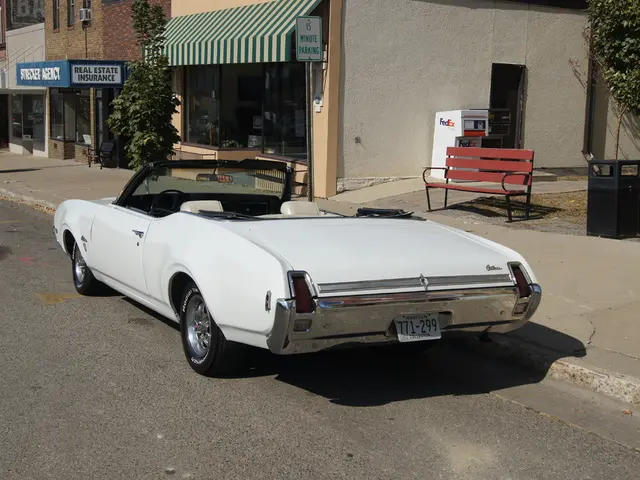Home Equity Line of Credit (HELOC) rates remain steady, contrasting with a slight increase in home equity loan rates
In the current economic climate, homeowners are increasingly turning to home equity loans and Home Equity Lines of Credit (HELOCs) to finance large-scale expenses. Recent data shows that home equity loan originations have risen by 13% year-over-year, while HELOC originations have increased by 8%.
The average rate on a $30,000 HELOC has remained unchanged at 8.27% for the fifth consecutive week, according to the Bankrate.com national survey of large lenders, conducted weekly and consistently in the same manner for over 30 years. The average rate on a $30,000 home equity loan has moved up two basis points to 8.28%. Over the past year, the average rates for both products have hovered in a similar range and are almost identical.
Homeowners decide between a home equity loan and a HELOC by carefully considering factors like borrowing purpose, personal finances, and current market conditions.
### Borrowing Purpose
Home equity loans are best suited for one-time, large expenses, such as debt consolidation, a major home renovation, or college tuition. They provide a lump sum upfront, allowing for fixed monthly payments over a set term with a fixed interest rate. In contrast, HELOCs are ideal for ongoing or variable expenses, like multiple home repairs over time, business startup costs, or gradual renovations. They operate like a credit line, allowing the borrower to draw funds as needed during the "draw period" and pay interest only on the amount used.
### Personal Finances
Creditworthiness plays a significant role in obtaining a home equity loan or HELOC. Home equity loans typically require a good credit score, reliable income, and sufficient home equity. They often come with lower interest rates compared to unsecured loans because the home acts as collateral. HELOCs offer flexible repayment options, including interest-only payments during the draw period, which can help manage cash flow. Home equity loans require fixed payments of principal and interest starting almost immediately, which is more predictable but less flexible.
Risk consideration is another factor to consider. Both are secured by the home, meaning missed payments can lead to foreclosure. The variability in HELOC interest rates can pose risks if rates rise, while home equity loans have the safety of fixed rates.
### Current Market Trends
Interest rates and credit limits are crucial factors to consider. HELOC rates tend to be variable and can fluctuate with market conditions, but recent trends show HELOC rates are generally lower than other unsecured borrowing types like credit cards or personal loans, making them attractive for some borrowers. HELOCs usually offer larger credit limits than home equity loans, which can be tempting for homeowners but may lead to over-borrowing and extended repayment periods if not managed carefully.
### Summary Table: Home Equity Loan vs. HELOC
| Factor | Home Equity Loan | HELOC | |----------------------|----------------------------------------|------------------------------------| | Best For | Large, one-time expenses | Ongoing or multiple expenses | | Disbursement | Lump sum upfront | Draw funds as needed | | Interest Rate | Fixed | Usually variable | | Repayment | Fixed monthly payments (principal + interest) | Payments vary; interest-only option often available initially | | Credit Limit | Generally lower | Generally higher | | Risk | Fixed payments, stable rates, less payment flexibility | Variable rates, payment variation |
### How Homeowners Decide
Homeowners balance their financial situation, borrowing needs, and appetite for risk to choose the best product between a home equity loan and a HELOC. If they want certainty and a fixed payment schedule for a large expense, they lean toward a home equity loan. If they prefer flexibility to borrow and repay multiple times over a few years, a HELOC is usually the better fit. Their creditworthiness and ability to manage fluctuating payments and rates heavily influence the decision. Market conditions such as current interest rates and lender offerings also sway choices, with some preferring the predictability of fixed rates amid potential rate hikes.
In essence, homeowners must carefully weigh their options and make informed decisions based on their unique circumstances when considering a home equity loan or a HELOC.
In the process of decision-making, homeowners deliberate over their personal finances, the purpose of borrowing, and current market trends when choosing between a home equity loan and a Home Equity Line of Credit (HELOC). For those requiring a fixed payment schedule for large, one-time expenses like major home renovations or debt consolidation, a home equity loan is often preferred due to its lump-sum disbursement and fixed interest rate. On the other hand, homeowners opting for flexibility in borrowing and repayment for ongoing or variable expenses, such as multiple home repairs or gradual renovations, tend to choose HELOCs, which operate similarly to credit lines and allow for interest-only payments during the draw period.




